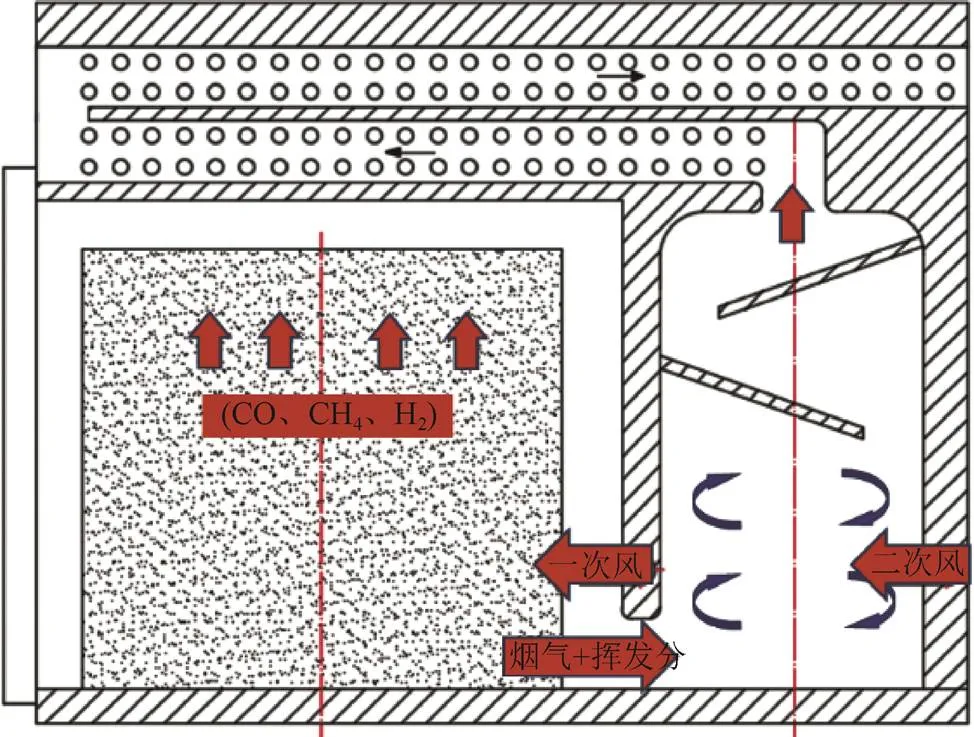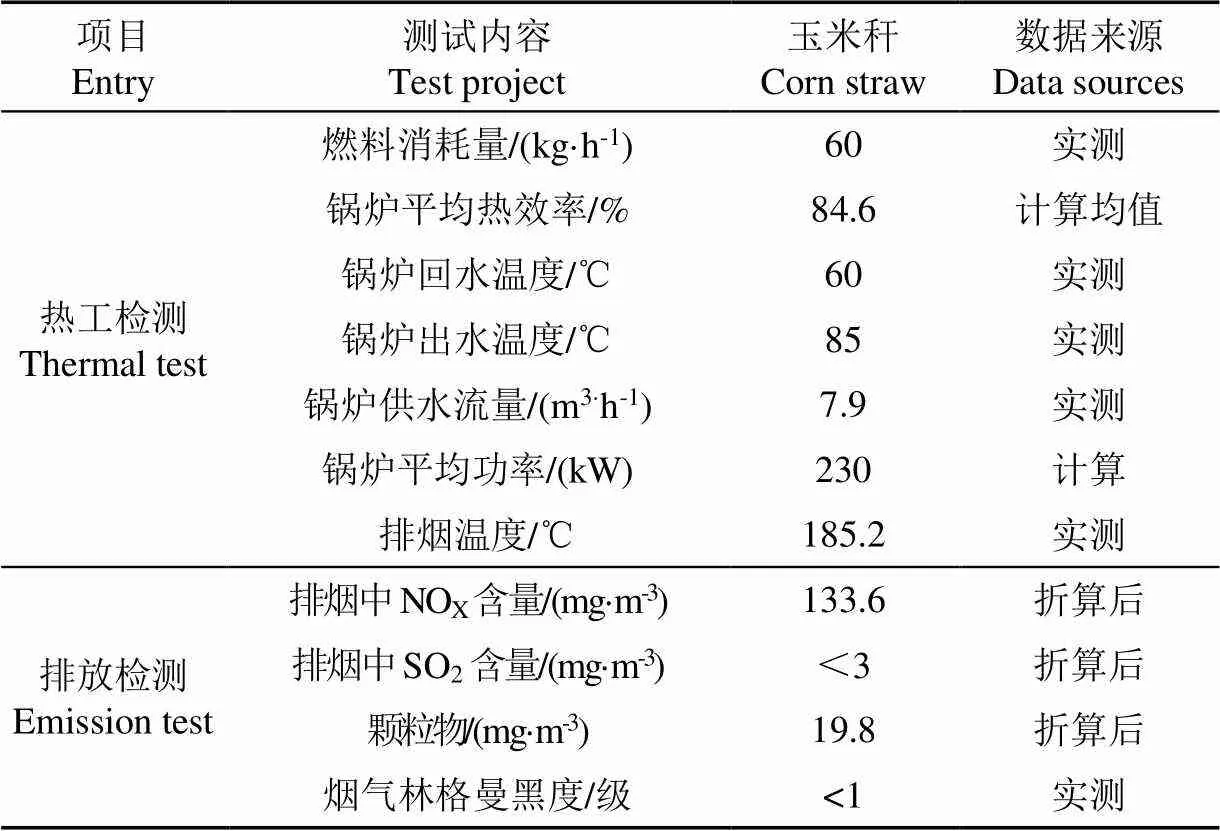秸秆捆烧锅炉设计及其排放特性研究
2019-02-21贾吉秀姚宗路赵立欣丛宏斌刘广华赵亚男
贾吉秀,姚宗路,赵立欣,丛宏斌,刘广华,赵亚男
秸秆捆烧锅炉设计及其排放特性研究
贾吉秀1,姚宗路1※,赵立欣2,丛宏斌2,刘广华3,赵亚男1
(1. 中国农业科学院农业环境与可持续发展研究所,北京 100081;2. 农业农村部规划设计研究院,农业部农业废弃物能源化利用重点实验室,北京 100125;3. 承德市本特生态能源技术有限公司,河北 067000)
针对中国现有秸秆捆烧锅炉燃烧不充分,燃烧后烟气净化工艺繁琐以及自动化程度较低等问题,该文基于原料分级、配风分级技术原理,设计了打捆秸秆分级燃烧系统,研发了多级配风系统和组合式烟气净化除尘装置等关键部件,并开发了智能控制系统,实现燃烧过程工艺参数的实时调控和数据采集。以打捆玉米秸秆为原料进行燃烧试验,结果表明秸秆捆烧供热锅炉的热效率为84.6%,锅炉功率为230 kW,烟尘排放平均质量浓度19.8 mg/m3,NOX质量浓度133.6 mg/m3,SO2质量浓度小于3 mg/m3,达到《锅炉大气污染物排放标准》(GB13271—2014)要求,解决了燃烧效率低、烟尘和NOx等污染物排放高的问题,智能化的锅炉燃烧系统可开展多种工艺试验的探索,为捆烧锅炉技术装备的推广应用提供平台支撑。
秸秆;排放控制;设计;秸秆捆;捆烧锅炉;分级燃烧;烟气除尘
0 引 言
中国农作物秸秆资源丰富、种类繁多,根据各省秸秆资源量调查和综合利用终期评估结果,2017年全国秸秆可收集量为8.37亿t,利用量为7亿t,综合利用率达到83.67%。然而废弃或就地焚烧的秸秆接近1.8亿t,造成了严重的环境污染和资源浪费,引发空气质量恶化、航班起降受阻等一系列问题[1]。近年来,在国家出台的一系列政策支持下,秸秆的综合利用工作得到了长足发展,秸秆捆烧等燃料化利用方式作为秸秆综合利用的重要途径之一,与生物转化和物理转化方法相比,它具备转化成本低、转化效率高、低污染和较好的原料适应性等优点,因此开发先进的秸秆捆烧锅炉系统装备,对于防治秸秆散烧,减少环境污染、节约化石能源等具有重要意义[2-6]。
秸秆捆烧技术是一种较好的秸秆能源化利用方式,是将田间松散的秸秆经过捡拾打捆后再燃烧供热的技术过程。秸秆打捆后提高了能量密度,降低了收储运成本,同时捆装后的秸秆半气化燃烧大幅提高了燃烧效率和锅炉供热效率,具有较好的经济效益。目前秸秆捆烧技术主要有2种,一种是间歇性的打捆秸秆锅炉燃烧系统,另一种是连续燃烧整捆秸秆的系统。国外秸秆打捆燃烧技术发展较早,在秸秆捆烧特性、配风燃烧技术、锅炉结构设计以及成套化设备研究等方面取得一定的研究进展,主要集中在欧洲国家的科研机构和企业,较为成熟的国家有丹麦、波兰、塞尔维亚、英国以及加拿大等[7-9];中国打捆燃烧技术研究起步较晚,打捆燃烧设备的研究较少,捆烧理论有待完善,河南农业大学对秸秆捆烧的燃烧特性、炉膛设计和烟尘减排等方面进行了研究,取得了较大的进展[10-11]。中国北方地区也有规模化的打捆直燃工程,但是在实际运行中仍然存在燃烧不充分、燃烧效率较低、氮氧化物排放过高、烟气净化工艺繁琐等问题。因此,完善秸秆捆烧理论,优化捆烧工艺,突破秸秆捆烧分级配风、低氮燃烧、炉内降尘、烟气处理等关键技术,提高捆烧燃烧效率,降低烟尘排放等,还需进行深入研究探索。
针对上述问题,本文通过半气化燃烧理论,基于原料分级、配风分级技术原理,设计了打捆秸秆分级燃烧系统并计算燃烧配风量,设计一体化组合除尘净化装置,开发关键参数的智能控制系统,进行样机试制并开展燃烧测试,探索捆烧最优工艺参数。
1 结构及工作原理
1.1 总体结构
秸秆捆烧设备主要由秸秆捆烧锅炉和后端烟气净化除尘装置组成。其中秸秆捆烧锅炉主要包括一次燃烧室、一次配风、二次燃烧室、二次配风以及挡板除尘器等,后端烟气净化除尘装置主要包括集静电除尘、旋风除尘和循环喷淋的一体化除尘装置和污水净化回用装置,具体组成结构如图1所示。

1.一次燃烧室 2.炉门 3.炉底 4.一次配风 5.二次燃烧室 6.二次配风 7.列管换热器 8.隔板 9.挡板 10.热烟气 11.烟气出口 12.省煤器 13.烟气入口 14.污水排出口 15.净化水箱 16.回流泵 17.旋风筒壁 18.鱼骨型阴极 19.烟气出口 20.阴极穿墙套管 21.环形布水管 1.Primary combustion chamber 2.Fire door 3.Hearth bottom 4.Primary air distribution 5.Secondary combustion chamber 6.Secondary air distribution 7.Tube heat transfer 8.A partition 9. Baffle 10.Hot smoke 11.Flue gas outlet 12.Economizer 13. Flue gas inlet 14. Sewage outlet 15.Purification tank 16. Reflux pump 17.Cyclone wall 18.Fishbone cathode 19.Flue gas outlet 20.Cathode wall bushing 21.Annular distribution pipe
1.2 工作原理
设备正常运行时,将打捆后的秸秆放置于一次燃烧炉腔中,炉腔内配备多点均布式的一次风,控制过量空气系数以保证打捆秸秆的半气化燃烧,燃烧过程中打捆秸秆依次经历水分蒸发、挥发分的析出及焦炭形成等阶段[12-13];燃烧产生的挥发分与热烟气进入第二燃烧炉腔,通过第二炉腔的切向配风管结构,对烟气中的挥发分进行二次旋流燃烧,同时第二燃烧炉腔上设置的交叉挡板可以延长烟气停留时间,促进烟气中可燃气体的燃尽。
燃烧过程中产生的热量经过炉腔的辐射换热和热烟气的对流换热后传递给循环水用于供暖,换热后的热烟气进入烟气净化除尘系统,产生的灰渣经过炉排输送至排渣口排出。烟气进入净化除尘系统后,经历旋风除尘、静电除尘和喷淋除尘的组合除尘工艺,将烟气中的灰尘颗粒集中到循环水中,再经历循环水箱的过滤除尘后,清洁的循环水再经循环泵输送至除尘器,循环使用,保证捆烧烟气的达标排放。
1.3 主要技术参数
设计锅炉功率230 kW,燃料消耗量为60 kg/h,试制的锅炉外形尺寸长3 026 mm,宽2 178 mm,高2 407 mm;锅炉可装填小方捆和大圆捆,小方捆外形尺寸为700 mm×450 mm×350 mm,一次可装填24捆,大圆捆外形尺寸为1 200 mm×1 300 mm,一次可以装填1捆。
2 关键部件设计
2.1 多级燃烧室配风系统设计
根据捆烧锅炉结构设计及秸秆燃烧特性,分析捆烧秸秆的燃烧原理如图2,将秸秆捆烧分为秸秆半气化一次燃烧和挥发分二次燃烧2个燃烧过程。其中,结合秸秆气化反应条件[14],控制一次燃烧室温度为600~800 ℃,过量空气系数控制为0.8~1.0,使秸秆中的半纤维素、纤维素和木质素等发生热分解反应,产成挥发性气体,气体中主要的可燃成分为CO、CH4、H2,二次燃烧室配备二次风对可燃气体进行二次燃烧,生物质中挥发分燃烧产生的热量约占生物质总热量的70%,因此捆烧过程中挥发分的充分燃烧控制决定了锅炉的燃烧效率[15-18]。

图2 秸秆捆烧原理图
燃料燃烧所需的空气量主要取决于燃料中可燃元素成分的含量,可燃元素完全燃烧所需的空气量即理论空气量,根据公式 (1)计算。锅炉实际运行时,通过控制过量空气系数控制打捆秸秆一次配风量,维持秸秆半气化燃烧状态,实际配风量根据公式(2)、(3)计算。其中,根据生物质气化技术原理,燃烧过程中挥发性气体约为1.2 m3/kg,具体组分如表1所示,所需二次配风量如式 (4)、(5)所示[19]






结合前人秸秆内热式气化原理技术研究[20],秸秆热解气化产生的可燃气组分主要为CO、H2和CH4。在锅炉配风计算时,本文参考河北省肥乡区秸秆气化站燃气组分测试结果,如表1所示,由公式(1)、(2)、(3)计算可得,第一燃烧室每千克打捆秸秆燃烧所用的理论空气量为3.64 m3/kg,实际空气量为3.28 m3/kg,一次燃烧实际配风量为196.7 m3/h;由公式(4)、(5)计算所得,每标方挥发分气体燃烧理论空气量为1.16 m3,实际空气量为1.74 m3,二次燃烧室实际配风量为125.3 m3/h。

表1 挥发性气体组分测试结果
2.2 烟气净化除尘系统
烟气净化除尘系统主要由烟气入口、旋风筒、鱼骨型电极、环形布水管、切向喷头、排污口、烟气出口、污水管道、污水净化装置和回流泵组成。烟气入口与旋风筒体切向连接,筒内悬挂鱼骨型阴极棒,旋风筒壁为阳极,形成高压静电场;筒体内壁固定环形布水管,布水管等间距布置12个水平切向的喷嘴,循环水喷出后在旋风筒内壁形成一层水膜。设备启动时,含颗粒的烟气由底部向上运动过程中,颗粒物受离心力和库仑力的作用向筒壁运动,再由水膜不断冲刷到底部的排污口,污水经过净化分离后再回流喷淋利用。集成了旋风分离、静电除尘和循环水喷淋除污等技术原理,简化了烟气净化除尘工艺,降低了烟气除尘成本。
经过测定,捆烧秸秆燃烧换热后烟气温度约为150 ℃,参照《除尘技术手册》,根据公式(4)、(5)、(6)、(7)确定旋分离器尺寸[21-24]。




式中V为标况下烟气流量,取480 m3/h;V1为工况下烟气流量,m3/h;为旋风入口的高度,m;为旋风入口的宽度,m;u为高温烟气的入口速度,取20 m/s;为旋风筒体直径,m;为拍尘口直径,取0.07 m;为旋风筒底锥顶角,°。
将烟气量代入公式可得旋风入口高度为0.14 m,宽度为0.07 m,旋风筒内直径为0.28 m,筒底锥顶角为21.2°。鱼骨型阴极线上相邻的鱼骨针程90°或60°交错排列,相邻的间距为80 mm,根据筒体直径设计静电场强度,保证2~3 kV/dm的静电场强度,实现较好的静电除尘效果。
2.3 智能控制系统
基于PLC开发的秸秆捆烧锅炉的控制系统如图3所示,主要包括人机交互系统、炉膛压力控制系统、炉膛温度控制系统、智能配风系统以及温度和压力预警系统。其中炉膛压力采用炉膛负压传感器测得的实时炉膛压力与设计要求值的偏差为调节信号,调节引风机变频器频率,实现对炉膛压力的闭环调节;炉膛温度是采用温度传感器与目标设定偏差为反馈信号,通过调节配风量对燃烧负荷进行闭环调节;根据每个进风口电磁阀的开度,分别调节一次风和二次风配风量。并加设压力预警和温度预警模块,实现整个燃烧状态的实时监测和控制。

图3 智能控制系统原理
利用组态软件Visual Basic开发的人机界面如图4所示,主要分为控制界面、参数设置界面和参数保存界面,可以在控制界面实现进料、点火、水循环、引风及鼓风的起停控制,在参数设定界面设定温度和压力的预警范围,在参数的保存界面实现炉膛温度、出水温度、烟气温度、炉膛压力、配风量以及烟气流量等参数的采集与存储,并可以调出进行表格显示或者曲线显示等功能。

图4 智能控制人机交互界面
3 燃烧与排放特性试验
3.1 试验材料与测试方法
样机完成后进行了秸秆燃烧与排放特性试验,选取辽宁省朝阳市小方捆玉米秸秆作为原料,原料的工业分析见表2,低位热值为12.5 MJ/kg,含水率为15%。小方捆横截面为450 mm×350 mm、长度为700 mm,共计24捆一次性装入炉膛中,打捆燃料密度约为108.8 kg/m3。

表2 玉米秸秆打捆燃料分析
装入原料后打开锅炉控制系统和配风系统,设定炉膛温度为800 ℃,炉膛压力为10 Pa,人工点火后约15 min炉膛温度达到稳定状态,此时进行烟气排放测试和锅炉热平衡测试,稳定状态下测试时长3 h,根据GB13271—2014《锅炉大气污染物排放标准》和GB5468—1991《锅炉烟尘测试方法》进行锅炉烟气排放的检测,采用的主要仪器有QUINTOX-KM9106综合烟气分析测量仪、F732-VJ测汞仪、林格曼黑度图、崂应3072型智能双路烟气采样器等设备[25];按照GB/T10180—2003《工业锅炉热工性能试验规范》测量锅炉和回水温度差、管道水流量检测、排烟温度、过量空气系数、炉渣热损失、炉体外表面温度等指标来计算锅炉正反平衡热效率,采用的主要仪器有QUINTOX-KM9106综合烟气分析测量仪、便携式快速红外测温仪、烟气黑度仪、微机全自动立式量热仪、林格曼黑度图、烘干箱以及马弗炉等仪器设备[25]。
3.2 结果分析
试验测得的结果如表3所示,秸秆捆烧锅炉的出水流量、出水温度均满足设计要求,锅炉热效率达84.6%,平均功率达230 kW;同时秸秆捆烧锅炉的烟气排放中NOx质量浓度为133.6 mg/m3,SO2质量浓度小于3 mg/m3,均低于国家排放要求,烟尘含量和林格曼黑度也符合环保指标,说明该锅炉达到了设计要求。

表3 秸秆捆烧锅炉燃烧性能试验结果
3.3 效益分析
以该秸秆捆烧锅为例,每小时消耗秸秆量为60 kg,功率达230 kW,供暖面积可达1 200 m2,秸秆捆的市场价格在180~240元/t,供暖季按照150 d计算,每天平均供热8 h,每年供暖的燃料成本为10.8~14.4元/m2。如表 4所示,对比烟煤供暖的燃料成本为11.7~16.8元/m2,生物质颗粒燃料供暖的燃料成本为24.4~32.5元/m2,秸秆捆烧供暖在燃料使用费上具有较好的经济性[26-27]。另外,捆烧秸秆供暖代替煤炭供暖,每年每平米减少SO2排放0.38 kg,减少CO2排放1.54 g,具有较好的环保效益[28]。

表4 不同供暖方式运行燃料成本
4 结 论
1)针对中国现有秸秆捆烧锅炉燃烧不充分,燃烧后烟气净化工艺繁琐以及自动化程度较低等问题,基于原料分级、配风分级技术原理,设计了打捆秸秆分级燃烧系统和组合式烟气净化除尘装置,开发了智能控制系统,为秸秆捆烧试验提供平台支撑。
2)玉米秸秆的捆烧试验表明,锅炉热效率达84.6%,烟尘排放平均质量浓度19.8 mg/m3,NOX质量浓度133.6 mg/m3,SO2质量浓度小于3 mg/m3,达到《锅炉大气污染物排放标准》(GB13271—2014)要求,具有较好的经济效益和环保效益。
3)该捆烧锅炉具有燃烧温度、进风量、引风量和炉膛压力等关键参数的实时监控和数据记录等功能,可以进行不同工况的燃烧试验,为下一步燃烧工艺优化提供平台支撑。
[1]霍丽丽,赵立欣,孟海波,等. 中国农作物秸秆综合利用潜力研究[J]. 农业工程学报,2019,35(13):218-224. Huo Lili, Zhao Lixin, Meng Haibo, et al. Study on straw multi-use potential in China [J]. Transactions of the Chinese Society of Agricultural Engineering (Transactions of the CSAE), 2019, 35(13): 218-224. (in Chinese with English abstract)
[2]丛宏斌,赵立欣,王久臣,等. 中国农村能源生产消费现状与发展需求分析[J]. 农业工程学报,2017,33(17):224-231. Cong Hongbin, Zhao Lixin, Wang Jiuchen, et al. Current situation and development demand analysis of rural energy in China[J]. Transactions of the Chinese Society of Agricultural Engineering (Transactions of the CSAE), 2017, 33(17):224-231. (in Chinese with English abstract)
[3]葛慧,郭志强,杨林,等. 农林生物质替代城镇煤炭供热发展研究[J]. 农业工程学报,2016,6(5):44-48. Ge Hui, Guo Zhiqiang, Yang Lin, et al. Heating technology development of agricultural and forestry biomass substitutes for urban coal[J]. Transactions of the Chinese Society of Agricultural Engineering (Transactions of the CSAE), 2016, 6(5): 44-48. (in Chinese with English abstract)
[4]刘圣勇,王艳玲,白冰,等. 玉米秸秆致密成型燃料燃烧动力学分析[J]. 农业工程学报,2011,27(9):287-292. Liu Shengyong, Wang Yanling, Bai Bing, et al. Analysis on combustion kinetics of corn stalk briquetting densification fuel[J]. Transactions of the Chinese Society of Agricultural Engineering (Transactions of the CSAE), 2011, 27(9): 287-292. (in Chinese with English abstract)
[5]姚宗路,赵立欣,Ronnback M,等. 生物质颗粒燃料特性及其对燃烧的影响分析[J]. 农业机械学报,2010,41(10):97-102. Yao Zonglu, Zhao Lixin, Ronnback M, et al. Comparison on characterization effect of biomass pellet fuels on combustion behavior[J]. Transactions of the Chinese Society for Agricultural Machinery, 2010, 41(10): 97-102. (in Chinese with English abstract)
[6]张品,刘圣勇,王炯,等. 国内外生物质捆烧技术及设备的研究现状[J]. 工业锅炉,2015(6):10-15. Zhang Pin, Liu Shengyong, Wang Jiong, et al. Research status of straw bales combustion technology at home and abroad[J]. Industrial Boilers, 2015(6): 10-15. (in Chinese with English abstract)
[7]Erik F K, Jens K. Development and test of small-scale batch-fired straw boilers in Denmark[J]. Biomass and Bioenergy, 2004, 26: 561-569
[8]Branislav R D, Dejan D, Aleksandar E. Development of a Boiler for Large Straw Bales Combustion, Paths to Sustainable Energy[M]. Dr Artie Ng (Ed. ), Croatia: InTech Europe, 2010.
[9]Rastko M, Dragoljub D, Aleksandar E. The boiler concept for combustion of large soya straw bales[J]. Enery, 2009, 34(5): 715-723.
[10]王翠苹,李定凯,王凤印,等. 生物质成型颗粒燃料燃烧特性的试验研究[J]. 农业工程学报,2006,22(10):174-177. Wang Cuiping, Li Dingkai, Wang Fengyin, et al. Experimental study on the combustion characteristics of biomass pellets[J]. Transactions of the Chinese Society of Agricultural Engineering (Transactions of the CSAE), 2006, 22(10): 174-177. (in Chinese with English abstract)
[11]刘圣勇,白冰,刘小二,等. 生物质捆烧锅炉的设计与研究[J],太阳能学报,2010,31(12):1527-1531. Liu Shengyong, Bai Bing, Liu Xiao’er, et al. Design and study of a biomass bales combustion boiler[J]. Acta Energiae Solaris Sinica, 2010, 31(12): 1527-1531. (in Chinese with English abstract)
[12]田松峰,罗伟光,荆有印,等. 玉米秸秆燃烧过程及燃烧动力学分析[J]. 太阳能学报,2008,29(12):157-159. Tian Songfeng, Luo Weiguang, Jing Youyin, et al. Combustion process and kinetics analysis of cornstalk[J]. Acta Energiae Solaris Sinica, 2008, 29(12): 157-159. (in Chinese with English abstract)
[13]杨帅,杨树斌,甘云华,等. 生物质成型燃料热解特性及动力学研究[J]. 节能技术,2010,28(3):199-205. Yang Shuai, Yang Shubin, Gan Yunhua, et al. Study on the pyrolysis characteristics and kinetics of biomass moulding fuel[J]. Energy Conservation Technology, 2010, 28(3): 199-205. (in Chinese with English abstract)
[14]赵京,魏小林,李森,等. 上吸式秸秆气化炉中当量比对气化特性的影响[J]. 中国电机工程学报,2017,37(S1):118-122. Zhao Jing, Wei Xiaolin, Li Sen, et al. Effect of equivalence ratio on gasification characteristics in a straw updraft gasifier[J]. Proceedings of the CSEE, 2017, 37(S1): 118-122. (in Chinese with English abstract)
[15]赵立欣,贾吉秀,姚宗路,等. 生物质连续式分段热解炭化设备研究[J]. 农业机械学报,2016,47(8):221-226. Zhao Lixin, Jia Jixiu, Yao Zonglu, et al. Equipment for biomass continuous grading pyrolysis[J]. Transactions of the Chinese Society for Agricultural Machinery, 2016, 47(8): 221-226. (in Chinese with English abstract)
[16]高玉宽,陈炳荣,朱小云,等. 卧式内燃燃油和燃气锅炉的结构和设计[J]. 热能动力工程学报,1999(14):122-125. Gao Yukuan, Chen Bingrong, Zhu Xiaoyun, et al. Structure and design of horizontal internal combustion oil and gas fired boiler[J]. Journal of Thermal Energy and Power Engineering, 1999(14): 122-125. (in Chinese with English abstract)
[17]刘明. 生物质气化及其燃气燃烧试验研究与分析[D]. 天津:天津大学,2008. Liu Ming. Experimental Research and Analyse on Biomass Gasification and Biogas Combustion[D]. Tianjin: Tianjin University, 2008. (in Chinese with English abstract)
[18]常兵. 配风方式对层燃炉燃烧特性影响的试验研究[D]. 上海:上海交通大学,2007Chang Bing. Experimental Study of the Influence on the Combustion Charicteristics in the Stoker Boiler by Air Distribution Modes[D]. Shanghai: Shanghai Jiaotong University, 2007. (in Chinese with English abstract)
[19]姚宗路,仉利,赵立欣,等. 生物质热解气燃烧装置设计与燃烧特性试验[J]. 农业机械学报,2017,48(12):299-305. Yao Zonglu, Zhang Li, Zhao Lixin, et al. Gas burner design and experiment on emission characteristic of biomass pyrolysis gas[J]. Transactions of the Chinese Society for Agricultural Machinery, 2017, 48(12): 299-305. (in Chinese with English abstract)
[20]李斌,陈汉平,杨海平,等. 上吸式生物质气化炉的设计与试验[J]. 农业工程学报,2011,27(7):270-273. Li Bin, Chen Hanping, Yang Haiping, et al. Design and experiment on updraft biomass gasifier[J]. Transactions of the Chinese Society of Agricultural Engineering (Transactions of the CSAE), 2011, 27(7): 270-273. (in Chinese with English abstract)
[21]张志通. 燃煤排放除尘净化技术的研究与比较[J]. 北华航天工业学院学报,2018,28(3):15-17. Zhang Zhitong. Comparative study of purification technology for coal dust removal[J]. Journal of North China Institute of Aerospace Engineering, 2018, 28(3): 15-17. (in Chinese with English abstract)
[22]Yin C, Rosendahl L, Kaer Sk, et al. Mathematical modeling and experimental study of biomass combustion in a thermal 108 MW grate-fired boiler[J]. Energy & Fuels, 2008, 22(2): 1380-1390.
[23]张永亮,赵立欣,姚宗路,等. 生物质固体成型燃料燃烧颗粒物的数量和质量分布特性[J]. 农业工程学报,2013,29(19):185-192. Zhang Yongliang, Zhao Lixin, Yao Zonglu, et al. Distribution characteristics of number and mass for particulate emission of biomass solid fuel combustion[J]. Transactions of the Chinese Society of Agricultural Engineering (Transactions of the CSAE), 2013, 29(19): 185-192. (in Chinese with English abstract)
[24]徐飞,赵立欣,孟海波,等. 生物质颗粒燃料热风点火性能的试验研究[J]. 农业工程学报,2011,27(7):288-294. Xu Fei, Zhao Lixin, Meng Haibo, et al. Experimental study on hot-air ignition of biofuel pellets[J]. Transactions of the Chinese Society of Agricultural Engineering (Transactions of the CSAE), 2011, 27(7): 288-294. (in Chinese with English abstract)
[25]刘恩海,刘圣勇,白冰,等. 玉米秸秆打捆燃料燃烧动力学模型[J]. 农业工程学报,2013,29(24):218-225. Liu Enhai, Liu Shengyong, Bai Bing, et al. Development of dynamic model of cornstalk bale combustion[J]. Transactions of the Chinese Society of Agricultural Engineering (Transactions of the CSAE), 2013, 29(24): 218-225. (in Chinese with English abstract)
[26]赖晓璐,周腰华,王兴伟,等. 辽宁省生物质燃料锅炉主要类型及供暖成本分析[J]. 辽宁农业科学,2017(6):60-62.
[27]王力力. 燃煤锅炉替代方案及各种燃料供暖成本分析[J]. 能源与节能,2017(1):70-72. Wang Lili. Analysis of alternative scheme of coal-fired boiler and various kinds of fuel heating cost[J]. Energy and Energy Conservation, 2017(1): 70-72. (in Chinese with English abstract)
[28]丛宏斌,赵立欣,孟海波,等. 生物质热解多联产在北方农村清洁供暖中的适用性评价[J]. 农业工程学报,2018,34(1):8-14. Cong Hongbin, Zhao Lixin, Meng Haibo, et al. Applicability evaluation of biomass yrolytic poly-generation technology on clean heating in northern rural of China[J]. Transactions of the Chinese Society of Agricultural Engineering (Transactions of the CSAE), 2018, 34(1): 8-14. (in Chinese with English abstract)
Design and emission characteristics of straw bales fuel combustion-boiler
Jia Jixiu1, Yao Zonglu1※, Zhao Lixin2, Cong Hongbin2, Liu Guanghua3, Zhao Yanan1
(1.,,100081,; 2.,,,100125,;3.,067000,)
As an important way of straw comprehensive utilization, straw bales combustion has the advantages of low cost, high efficiency, low pollution and better adaptability of raw materials. However, there still exist the problems such as low combustion efficiency, complex flue gas purification and low automation of straw bales combustion. Based on thecombustion theory of raw material classification and air distribution classification technology, we designed the secondary air distribution device, which consists of two combustion chambers. In the first combustion chamber, a primary air was provided to ensure gasification reaction. In the second combustion chamber, a secondary air was provided to ensure gas combustion, which realized the full combustion of straw. At the same time, we developed a dust removal device and the intelligent control system, and built a straw bale boiler test platform, which realized real-time control of bale burning and data acquisition. The design power of the boiler was 230 kW, the fuel consumption was 60 kg/h, and the overall dimension of the trial boiler was 3 026 mm×2 178 mm×2 407 mm; the boiler could be filled with small square bundles and large round bundles, the overall dimension of small square bundles was 700 mm×450 mm×350 mm, 24 bundles could be filled at a time, and the overall dimension of large round bundles was 1 200 mm×1 300 mm, and one round bundle could be filled at a time. The boiler mainly included primary combustion chamber, primary air distribution chamber, secondary combustion chamber, secondary air distribution and baffle dust remover. The flue gas purification and dedusting device mainly included electrostatic dedusting, cyclone dedusting, circulating spray and sewage purification and reuse device. The intelligent control system mainly included human-computer interaction system, furnace pressure control system, furnace temperature control system, intelligent air distribution system and temperature warning system.When the equipment works, we could open the boiler control system and air distribution system after loading the raw materials, set the furnace temperature as 800 ℃, furnace pressure as 10 Pa, and the furnace temperature would reach a stable state about 15 minutes after manual ignition. At this time, the flue gas emission test and boiler heat balance test were carried out, and the test duration at the stable state was 3 hours. Tested with corn stalk as raw material, the result showed that the thermal efficiency of straw-fired boilers was 84.6%, the heat load was 230 kW, the average concentration of soot emissions was 19.8 mg/m3, the concentration of NOXwas 133.6 mg/m3, and the concentration of SO2was<3 mg/m3, which met the requirements of (GB13271-2014). Taking this boiler as an example, the annual heating fuel cost was 10.8-14.4 yuan/m2, which had an advantage in heating costs, and had a good benefit for environmental protection compared with coal heating and biomass pellet heating. The intelligent combustion platform also can carry out various process tests, and the next step is to carry out combustion tests under different working conditions and explore different combustion processes, which can provide a basis for further optimization.
straw; emission control; design; straw bales fuel; air distribution; dust removal
贾吉秀,姚宗路,赵立欣,丛宏斌,刘广华,赵亚男. 秸秆捆烧锅炉设计及其排放特性研究[J]. 农业工程学报,2019,35(22):148-153.doi:10.11975/j.issn.1002-6819.2019.22.017 http://www.tcsae.org
Jia Jixiu, Yao Zonglu, Zhao Lixin, Cong Hongbin, Liu Guanghua, Zhao Yanan. Design and emission characteristics of straw bales fuel combustion-boiler[J]. Transactions of the Chinese Society of Agricultural Engineering (Transactions of the CSAE), 2019, 35(22): 148-153. (in Chinese with English abstract) doi:10.11975/j.issn.1002-6819.2019.22.017 http://www.tcsae.org
2019-09-05
2019-10-10
中国农业科学院科技创新工程协同创新任务(CAAS- XTCX2016011-01);现代农业产业技术体系专项资金资助(CARS-02-31)
贾吉秀,工程师,主要从事生物质能源技术与装备研究。Email:sdaujdjjx@163.com
姚宗路,研究员,博士,主要从事农业废弃物能源化利用技术研究。Email:yaozonglu@163.com
10.11975/j.issn.1002-6819.2019.22.017
TQ515
A
1002-6819(2019)-22-0148-06
